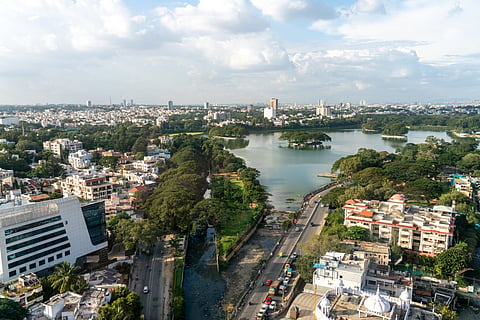
- Destinations
- Experiences
- Stay
- What's new
- Celebrating People
- Responsible Tourism
- CampaignsCampaigns
- Subscribe
- Buy Now

Bengaluru, historically known for its rich water resources, was once a city dotted with numerous wells, tanks, various lakes, and canals that offered residents a refreshing respite from the intense pace of urban life. Official records from 1876 reveal that the city boasted an impressive 16,725 open wells, 2,300 tanks, and 354 canals, all of which played a vital role in supporting the local ecosystem and providing water for its inhabitants. At that time, these water bodies were integral to daily life and the charm of the city.
However, the rapid urbanisation and development that characterised the city in recent years led to a troubling decline in these natural resources. A mapping exercise carried out in 2015 starkly illustrated this decline, revealing that only about 10,000 wells remained. This significant reduction raises concerns about water sustainability and the preservation of Bengaluru’s once-abundant water heritage, as the city navigates the challenges of modern urban living. However, several people and organisations in Bengaluru are involved in reviving old wells through projects. Here is a look.
This initiative aims to restore wells to recharge groundwater and address the city's water crisis. The "Million Wells for Bengaluru" campaign seeks to revive traditional well-digging practices and enhance groundwater recharge in response to the city's water scarcity. Launched by the Biome Environmental Trust in 2015, the initiative focuses on constructing shallow recharge wells to capture rainwater and replenish groundwater levels.
Additionally, the campaign aims to provide livelihoods for the local community of well diggers, known as the Mannu Vaddars. Its goal is to raise the groundwater table and improve water availability in Bengaluru by integrating traditional well-digging techniques and the knowledge of the Mannu Vaddar community.
The project also seeks to revitalise the well-digging community, offering them sustainable livelihoods, encouraging residents to build and maintain their own recharge wells, and promoting individual responsibility in water conservation. Recharge wells are designed to channel excess rainwater from households or apartments back into the ground, thereby enhancing the city's water resilience.
Although the "Million Wells for Bengaluru" campaign is not directly initiated by UNESCO, it aligns with the organization's broader objectives of sustainable development and cultural preservation. The UNESCO World Heritage Centre has acknowledged this initiative as a prime example of how traditional practices can enhance sustainable water management and contribute to preserving cultural heritage.
SayTrees, a Bengaluru-based NGO, is dedicated to promoting sustainable practices in the city. They are involved in various initiatives, including well restoration, the creation of urban and rural forests, supporting farmers with fruit trees, and rejuvenating lakes and other water bodies. One notable project is the restoration of the Sampanigram Nagar Well, which now provides free, clean water to the community. Located in the heart of Shivajinagar’s bustling market, this historic well is 300 years old and measures 40 feet deep and 20 feet wide. Thanks to SayTrees, it has been restored to its former glory. They believe that restoring these wells is essential not only for preservation but also for securing water for the future.
Anand Malligavad, often referred to as the "Lake Man of India," has emerged as a prominent figure in the realm of water conservation and environmental protection. With a deep commitment to revitalising the ecosystem, he has achieved remarkable success in restoring numerous lakes across Bengaluru. His extensive work is particularly noted for adopting ancient Chola methods of water management, techniques that have proven to be both sustainable and efficient, requiring minimal maintenance over time. As of 2023, The New York Times highlighted Malligavad's impressive accomplishments, noting that he has played a pivotal role in the rejuvenation of 35 lakes in Bengaluru. His approach not only addresses water scarcity but also enhances local biodiversity, improves groundwater recharge, and provides recreational spaces for communities.
